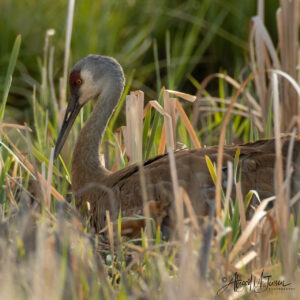Sandhill Crane Nest Camera

Greater Sandhill Cranes will return to the same general area every year to nest and typically build a nest in the same or similar spot. Nests are simple, mound-like platforms made of marsh plants, grasses and weeds piled on the ground in marshes or wet meadows. Sandhill Cranes in Colorado usually lay two eggs in late April or early May and incubate these eggs for about 30 days. Both crane parents will help in incubating the eggs and caring for the young once they hatch. When the eggs hatch, Sandhill Crane chicks are able to see, are covered in down feathers, and are able to walk within a few hours. After about a day, the chicks will leave the nest with their parents.
Learn more about Sandhill Crane nesting by checking out our Nesting FAQs! Watch our 2021 webinar: Everything You Want to Know About Greater Sandhill Crane Nesting.
Watch the Nest Camera Highlights to see all the excitement in short video clips!
The Crane Nest
In 2021, we watched Sandhill Crane pair Rocky and Athena successfully hatch one egg. In 2022, Rocky and Athena returned to their nesting area but nested just beyond the range of the Nest Camera. So in 2022, we followed a different Sandhill Crane pair, Fred and Wilma, as they successfully hatched one egg and raised that chick for several weeks. In 2023, we again witnessed the nesting saga of Rocky and Athena, who successfully produced two adorable chicks, Cinnamon and Sage, both of whom hatched on the same day. The family hung around the camera for several weeks before leaving the area.
This year, 4 cranes returned to the nest area on March 19th but were gone the next day. A few days later, an adult pair appeared on the scene, had territorial disputes with another pair, and engaged in nesting behaviors. Finally, this pair (Rocky and Athena) laid their first egg on April 15 at 2:04 pm and the second egg on April 18 at 6:46 am. Incubation is approximately 30 days so they are expected to hatch beginning on May 15.
Warning: This is a wild Sandhill Crane nest and anything can happen. While we hope the nest is successful and both eggs hatch, many things can happen to prevent this, including the eggs being infertile, predation of the eggs, chicks or adults, and natural disasters.
Disclaimer: We are livestreaming a wild bird nest and may experience technical problems. We cannot control problems related to mother nature, disrupted signals, etc. If you can’t play the video, try refreshing the webpage. Visit our Nest Camera Highlights page to see the best moments from this nest.
The live video feed was made possible through grants provided by the Yampa Valley Community Foundation and the WHILD fund. Internet access for live streaming is provided by Zirkel Wireless. Camera installation and setup were completed by Photon Syndicate. Updated equipment was possible because of generous individual donors. Thank you also to CCCC staff and volunteers for their tech support. Thank you to all our wonderful viewers without which this camera would not exist.






Leave a Reply